This site contains affiliate links. As an Amazon Associate, I earn a commission from qualifying purchases at no extra cost to you. Full Disclosure Here.
Ammunition is an integral part of any firearm. Different types of ammunition are available, and they vary significantly in terms of design, usage, performance, and cost. Ammunition can be classified based on its caliber, the type of primer, and the firearm type.
Centerfire and rimfire ammunition are the two primary types of ammunition that have been used for shooting and hunting for centuries.
In this guide, we’ll go over everything you need to know about these two types of ammunition. We’ll start with a quick rundown of the main difference between the two, then take some time to go more in-depth about each type in turn. Finally, we’ll go over the pros and cons of rimfire and centerfire ammunition to help you make an informed decision about which ammo type you need!
Now let’s dive right in with a quick discussion of the main difference between rimfire and centerfire ammunition.
What is the main difference between centerfire and rimfire ammunition?
Both centerfire and rimfire cartridges are designed to ignite the powder in the cartridge, which creates the pressure needed to propel the bullet out of the barrel. However, the main difference between these two types of ammunition is the location of the primer.
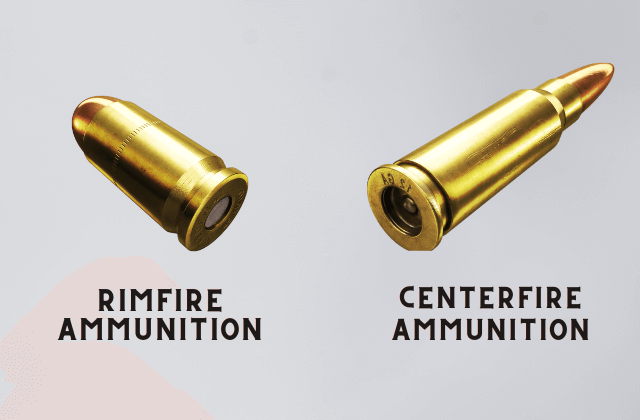
In centerfire ammunition, the primer is located in the center of the base of the cartridge. But in rimfire ammunition, the primer is located on the rim of the base of the cartridge.
This is important because the primer ignites the powder. This chemical reaction is what causes pressure to build up within the round until there’s enough pressure to fire the bullet.
In practice, this difference means that centerfire ammo can handle much higher pressure loads than rimfire ammunition, which allows it to be used for a wider variety of purposes. In contrast, pressure is a limiting factor for rimfire ammunition, so it’s only usable for things that require low power and short range.
Centerfire Ammunition – Detailed explanation
A centerfire cartridge is a type of ammunition with the primer located in the center of the base of the cartridge. The primer is a small metal cup containing a primary explosive that initiates the ignition of the gunpowder in the cartridge. A firing pin strikes the primer, and the resulting pressure causes the gunpowder to burn, propelling the bullet out of the barrel.
Centerfire ammo is a touch older than rimfire ammunition. The arguably oldest version was designed somewhere between 1808 and 1812 by Swiss gunsmith Jean Samual Pauly. However, this version didn’t have the percussion cap featured on modern centerfire ammo.
Despite not really being a gun or ammo designer, Swiss inventor Clement Pottet is typically considered the true inventor of centerfire ammunition thanks to adding a percussion cap and streamlining the design into the modern centerfire round.
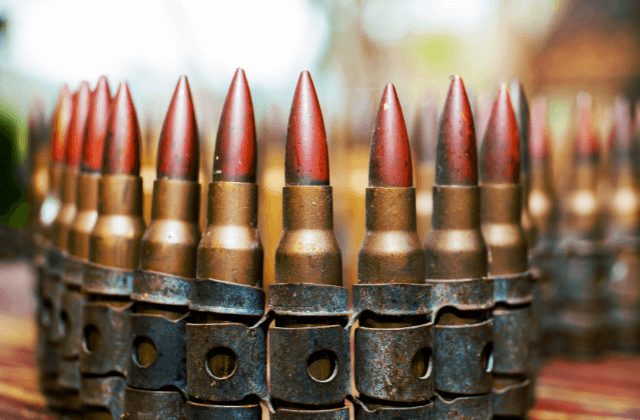
Centerfire ammunition is commonly used in rifles, handguns, and shotguns. Centerfire ammo is the most popular type of ammunition used by law enforcement and the military because it is reliable, accurate, and has more power than other types of ammunition.
Centerfire ammunition is available in various calibers, ranging from small calibers used for small game hunting to large calibers used for big game hunting and long-range shooting. Most common rounds are centerfire rounds, including 9mm, .45 ACP, and .223 Remington.
There’s also a huge number of different centerfire rounds in general though, ranging from incredibly popular to very niche. As a general rule, most commercial chamberings are going to be centerfire chamberings.
For example, most military rounds like 7.62×39, 5.56×45, and other common battle-ready rounds are centerfire. Most of what you’ll see on the shelf at your local sporting goods store or gun store will almost certainly be centerfire.
The main reason for this, and the primary appeal of, centerfire ammo is that it can be loaded at high pressures, making it great when you need a round with a lot of oomph. This makes it much more viable for things like hunting and defensive (or offensive, in the case of the military) usage.
You can use a much heavier projectile, and a heavy projectile provides greater energy and velocity, extending the range and enhancing the stopping power of bullets fired from centerfire rounds. These rounds are better suited to shooting at long ranges, and some extreme-long range (ELR) rounds can get hits on targets several miles away.
This makes it possible to design centerfire ammo for virtually any application. You’ll find ample centerfire options for just about any shooting purpose, including self-defense, big game hunting, and long-range or precision target shooting.
Centerfire ammo tends to be more reliable but is also more expensive than rimfire due to the extra materials and hardier construction required for those higher-pressure loads.
For the same reason, it’s heavier and bulkier, so carrying and storing centerfire ammo can be tricky, especially if you need to pack it for long distances or have limited space for ammo storage. Fortunately, most of us don’t need to hoard or carry thousands of rounds of ammunition.
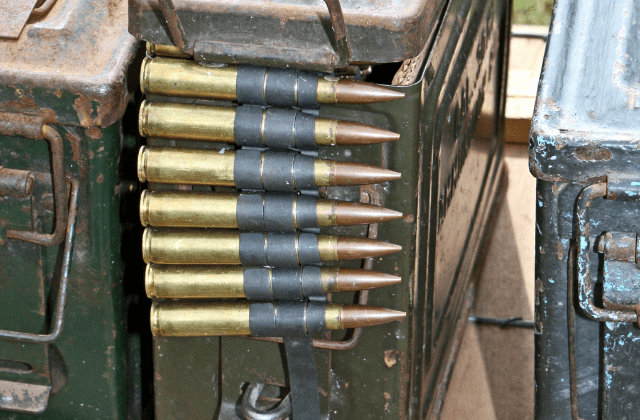
Due to the higher pressures involved, centerfire firearms are also commensurately more expensive than a rimfire firearm. Chambers and barrels must be built to contain much greater forces, and so are thicker and made of tougher (read: more expensive) steels.
Centerfire firearms are also typically harder to get ahold of outside of the United States and in more gun-restrictive countries. Rimfire ammo like .22LR is often used for sporting/target purposes in these places and is therefore easier to get your hands on.
Check your local/federal regulations and rules to see how this might impact you where you are. If you’re in the US though, there’s really no difference in purchasing a centerfire vs. a rimfire firearm.
Finally, the design of centerfire ammo allows it to be reloaded. For those not in the know, reloading or handloading is the process of creating your own ammunition by hand as opposed to buying factory loads. Reloading is technically when you make your own ammunition using brass recycled from a previous round of ammunition, but in practice, “reloading” and “handloading” are often used interchangeably.
Visit our article on the .308 vs .30-06 Centerfire Ammunition comparison.
The ability to handload centerfire ammo gives this type of ammunition a couple of additional advantages for those who are willing and able to take the time to handload.
For one, it reduces the cost per round, especially if you’re recycling brass. You can only really buy reloading supplies in bulk, so the cost upfront can be hefty. However, if you can swing the higher initial cost, it reduces the cost per round significantly.
The other advantage of handloading is the ability to create custom rounds. You need to mind pressure limits for the caliber to make sure that the round is safe for you and your firearm, but beyond that, you can design the exact round you want.
Rimfire Ammunition – Detailed explanation
Rimfire cartridges are a type of ammunition that has the primer located on the rim of the base of the cartridge. The rim of the cartridge is struck by the firing pin, which crushes the rim and ignites the priming compound. The priming compound then ignites the gunpowder, which generates pressure and propels the bullet.
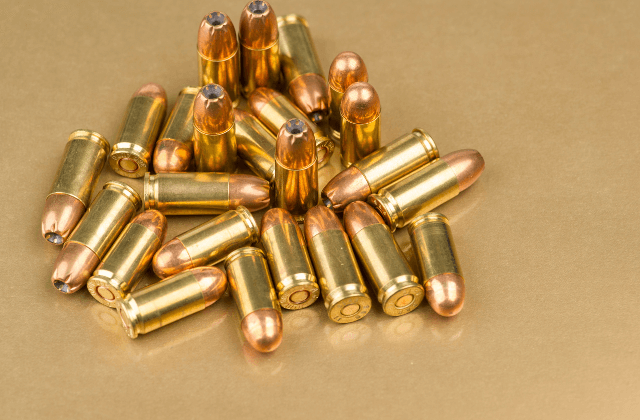
Rimfire ammunition is newer than centerfire ammo, but only by a tiny bit. Rimfire ammo came onto the scene in 1845 when French inventor Louis-Nicolas Flobert invented it. The first rimfire round was named accordingly, 6mm Flobert.
He developed and introduced another version of the round in 1888 that was similar enough that it shares the same name and functions more or less interchangeably.
6mm Flobert didn’t use powder for propellant, just the percussion cap. As a result, it was a very low-power round, only achieving muzzle velocities of about 700 to 800 feet per second. In contrast, modern .22LR generally has a muzzle velocity of around twice this, especially with lighter bullets.
The low-power design was intentional, though. Flobert designed his round for use with his parlor guns, which were pistols designed for indoor shooting within the home. Obviously, you don’t want a round that will hurt people or damage property for this, so a very low velocity is essential for this type of shooting. You definitely shouldn’t try this in your own home, though, with any round.
Going back to .22LR (or .22 Long Rifle), it wasn’t the second rimfire round, with a few others introduced before .22LR was introduced by J. Stevens Arms & Tool Company in 1887. It is, however, the most popular rimfire round in current times, in both the United States and around the world. And it’s not even close.
Rimfire cartridges are commonly used in small caliber handguns or rifles, due to the low-pressure levels and small size of the cartridge. Most rimfire ammunition is either .22 or .17 caliber.
You can check our article on the Best 22LR Rimfire Scopes.
There are fewer types of rimfire rounds compared to centerfire ones, and very few rimfire rounds among the most popular ammo calibers in general. Aside from .22LR, other common rimfire rounds include .17 Hornet, .22 Magnum, and .17 HMR.
These rounds, along with the .22LR variant, .22 Short, will be available in most sporting goods and gun stores. Other rimfire rounds can be harder to find in brick-and-mortar stores and even online in some cases, but it’s also hard to find guns chambered for these calibers, so you’re unlikely to be looking for them anyway.
Modern rimfire rounds are more powerful than Flobert’s tiny 6mm, but they’re still very low in power compared to centerfire ammo.
Because of their low pressure, rimfire rounds are limited in their application. It’s generally reserved for hunting varmints and small game or plinking.
There are also a wide variety of shooting competition styles that specifically use rimfire ammunition, like NRL22. Many competitions that typically use centerfire ammo have rimfire classes, like benchrest and steel challenge shooting. Rimfire is even used in some Olympic shooting events.
That said, it simply doesn’t have the power needed for long-range or heavy-hitting shots. Don’t underestimate rimfire, though: while it doesn’t have the power of centerfire, that just makes it different from centerfire ammo, not worse. In fact, that lower power is an advantage in several ways. There are, after all, reasons that so many people shoot .22LR that it’s the most popular round on the block.
For one, that low pressure also makes rimfire rounds a great option for new shooters or shooters with low hand strength. It’s also just great if you want something easy and comfortable to shoot. You can shoot rimfire ammunition for hours at a time with little to no hand and arm fatigue.
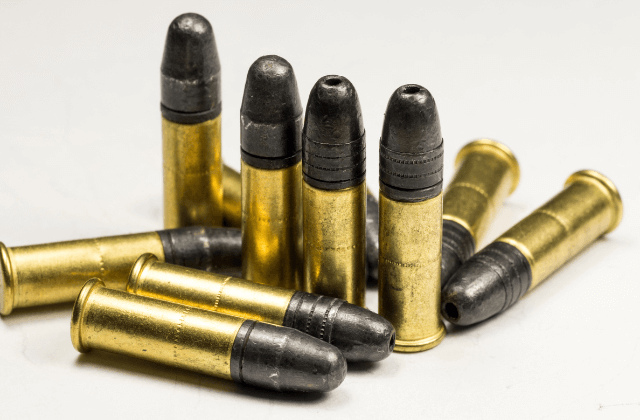
That same low power means little recoil, which makes follow-up shots faster and easier. That’s perfect for shooting small, fast-moving targets, like varmints and small game. It’s also great for fast-paced shooting in general.
Another advantage is accessibility, which is true in a few different ways.
First, if a store sells any ammunition at all, it will sell .22LR. This is something of a self-reinforcing pattern, where stores stock .22LR because it’s popular, then people choose to go with .22LR because it’s so easy to find. It’s been like this for decades, and there’s no sign of it changing any time soon.
The second is price. The good thing about more popular rounds is that they tend to be cheaper, but rimfire rounds generally tend to be much cheaper than centerfire rounds. Much of this is simply that rimfire ammunition is cheaper to produce. It requires fewer materials and doesn’t need to be as ruggedly constructed, thanks to the lower pressure. Those savings in manufacturing get passed on to you.
That means you can pick up 500 rounds for $40 to $50 (and less when ammo prices aren’t so inflated), working out to less than 10 cents a pop. You can shoot all day for about the price of dinner for two.
Third, rimfire is great for people who, for whatever reason, can’t or don’t want to shoot harder-hitting centerfire ammunition. For example, it’s great for new shooters who have a hard time controlling recoil. In fact, for many of us, a rimfire rifle was our first firearm back when we were kids.
It’s also a great choice for people in general with weak hands, including people with disabilities that limit hand strength.
There are a couple of key downsides to rimfire beyond the limited range and power.
First, it can’t be reloaded. Fortunately, it’s cheap enough that cost doesn’t need to be a motivator to reload.
Second, it is a bit less reliable than centerfire ammo, just by the nature of the design. Primer material has a tendency to be inconsistently distributed throughout the rim, so primers can fail. It’s still not an outrageous amount, only about 2%, and centerfire certainly isn’t immune to failure itself.
In fact, if you’re shooting a round that’s too powerful for your hand strength, that can result in what’s called a limp wrist malfunction, so be careful going that way too.
Centerfire vs Rimfire – Which is Better?
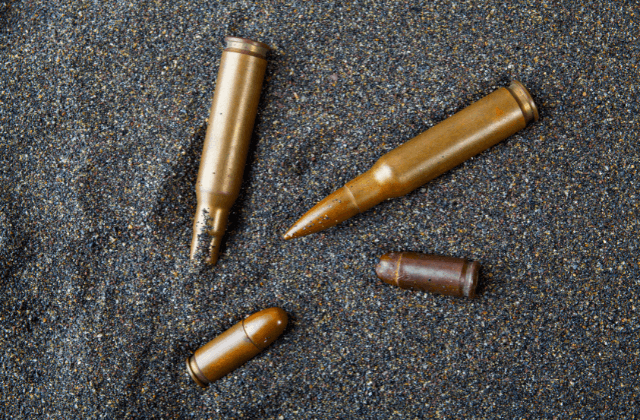
Pros of Centerfire Ammunition
The main advantage of centerfire ammunition over rimfire is that center ammo can be made with larger, more powerful powder charges. In turn, they can also handle larger projectiles and send those larger projectiles down range faster.
This is ideal for self-defense, hunting, and long-range shooting since larger, faster projectiles mean more energy. More energy means greater penetration and greater resistance to the various things that can impact a bullet’s trajectory, like gravity, wind, and air resistance.
Centerfire ammo is also pretty easy to reload or handload for the average person. You just need to pick up some basic equipment and learn some basics, then you can load your own ammo.
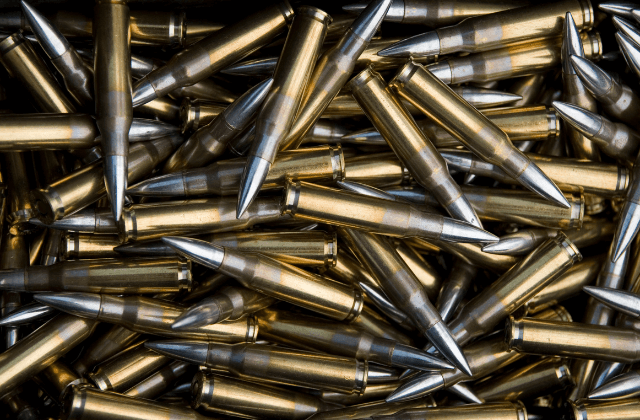
Reloading and handloading are a great way to save money over factory ammo and also allows you to customize your ammo to get exactly the performance that you want. It’s also just a neat hobby and experimenting with different loads can be a lot of fun! You just need to make sure you’re being safe too.
Cons of Centerfire Ammunition
Of course, those advantages come at a cost.
For one, there’s the literal cost. Centerfire ammunition uses more material to handle those higher pressures, and the simple fact of the matter is that more material costs more to produce, so that cost gets passed on to shooters.
That’s not to say that all centerfire ammunition is outrageously expensive, but it certainly tends to be more expensive than rimfire ammo.
The other downside of the additional material used for centerfire ammunition is extra weight and size. It’s simply harder to carry around centerfire ammunition in bulk. Even when diameters are similar, like .223 Remington and .22LR, the centerfire round is significantly larger and heavier.
Fortunately, most of us don’t need to carry around hundreds or thousands of rounds on us, certainly not over long distances. For hunting or EDC, most of us just carry a few rounds. For time at the range, you’ll want to bring more, but I’ve never had much of a walk from my car to the shooting bench.
With all that said, most shooters feel these downsides of centerfire ammo are worth it. That’s why almost all popular rounds are centerfire rounds, after all.
Pros of Rimfire Ammunition
The advantages and disadvantages of rimfire ammunition are basically the inverse of those for centerfire ammunition.
First of all, rimfire ammo uses less material than centerfire ammo does. This makes it very cheap to produce and, therefore cheap to purchase as well.
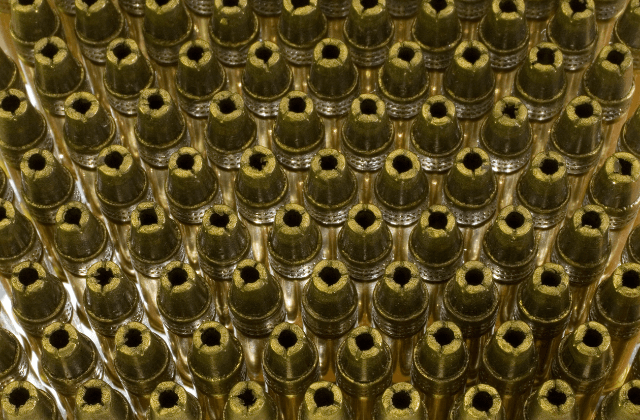
Sure, there are definitely options for high-end, match-grade rimfire ammunition if you want to buy something fancier and have the budget for it, but when it comes to rimfire ammo, most of us are looking for cheap ammo in bulk and there’s plenty of that out there. The high-end stuff is really just for rimfire competition, like NRL22.
It also makes rimfire ammunition lightweight and compact, so you can store a whole lot if it easily, which makes it very popular among both target shooters and preppers. You can also carry a whole lot of it without much weight.
For most .22LR rounds, for example, 100 rounds only weighs about .8 pounds, so it’s not a big deal to bring literally thousands of rounds to the range for a long day of shooting with friends. In fact, that’s something I’ve done many, many times.
And speaking of long days of shooting, because rimfire ammo has less energy than centerfire ammo, it’s incredibly easy and comfortable to shoot. Even people who’ve never held a gun before should be able to fire off round after round of rimfire ammo and not have their hands get tired, even after hours of shooting.
Cons of Rimfire Ammunition
Because of the way that rimfire ammo works, it’s significantly less powerful than centerfire ammo, with lower pressure and therefore lower velocity. Because of this, rimfire ammo is limited in its applications.
Target shooting is a popular use for rimfire ammo, but it can also be used for hunting very small game and varmints, like snakes, squirrels, and rabbits. While skilled (or lucky) shooters have certainly used it to harvest or eliminate larger animals, you’ll typically want to limit your hunting to animals below about 15 pounds at the absolute most with .22LR.
For the same reasons, you also can’t use rimfire ammo to shoot targets at very large distances. Rimfire rounds simply don’t have the mass or pressure to reach the velocity needed to travel very far. .22LR, for example, can be used at distances up to 150 yards, though the practical range for most shooters and purposes really tops out at around 100 yards.
Finally, rimfire can’t be reloaded and you’ll also want to be careful with dry firing. Without a training round, snap cap, or empty cartridge in the chamber, the firing pin can hit the chamber, which can damage your firearm.
Conclusion
Centerfire and rimfire ammunition are two different types of cartridges used in firearms. Centerfire ammunition has the primer located in the center of the base of the cartridge while rimfire ammunition has the primer located on the rim of the base of the cartridge.
Centerfire ammunition is more powerful, reliable, and accurate than rimfire ammunition, while rimfire ammunition is less powerful and less reliable but cheaper and more suitable for small game hunting and plinking.
Ultimately, the choice between these two types of ammunition depends on the firearm type, usage, and preference of the shooter.

